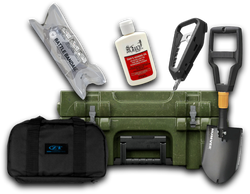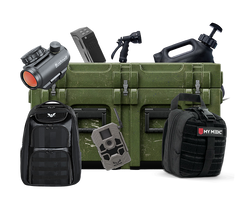What is a Pocket Knife? Understanding the Versatile Tool
Table of Contents
- Introduction
- The History of Pocket Knives
- Types of Pocket Knives
- Practical Uses of Pocket Knives
- Choosing the Right Pocket Knife
- Crate Club's Pocket Knife Offerings
- Conclusion
- FAQ
Introduction
Imagine standing in your kitchen, surrounded by various tools, and you suddenly realize that one item could simplify countless tasks. This is the power of a pocket knife. Pocket knives, often seen as mere tools, are actually versatile companions that have been an essential part of daily life for centuries. They are not only practical but also steeped in history, innovation, and craftsmanship.
As we explore the world of pocket knives, you'll discover their rich heritage, various types, and practical uses that extend beyond mere cutting. Whether you are a seasoned outdoor enthusiast, a DIY hobbyist, or someone simply looking to be prepared for everyday challenges, understanding what a pocket knife is and how it can be of service is essential.
By the end of this article, you will be equipped with a comprehensive knowledge of pocket knives, their various functionalities, and how to choose the right one for your needs. We will also highlight how Crate Club’s curated selection of tactical gear and survival tools can enhance your experience with pocket knives, ensuring you are always prepared.
The History of Pocket Knives
Pocket knives date back thousands of years, with the earliest known examples found in ancient civilizations. The design has evolved significantly over the centuries, adapting to the needs of different cultures and technologies.
Ancient Origins
The first pocket knives were rudimentary tools made of stone or bone. They were primarily used for cutting and crafting, serving essential purposes in survival and everyday tasks. As metallurgy developed, so did the materials used in knife construction. By the Middle Ages, metal blades became commonplace, allowing for more durable and functional designs.
The Birth of the Modern Pocket Knife
The modern pocket knife began to take shape in the 19th century, particularly in Switzerland. The Swiss Army knife is one of the most iconic examples, combining multiple tools into one compact design. This innovation paved the way for the multifunctional tools we see today, which can include blades, screwdrivers, can openers, and more.
Cultural Significance
In many cultures, pocket knives symbolize self-reliance and practicality. They are often gifted to children as a rite of passage, teaching them responsibility and the importance of being prepared. Today, pocket knives are not only functional tools but also collectible items, with enthusiasts valuing craftsmanship and unique designs.
Types of Pocket Knives
Understanding the different types of pocket knives is crucial for selecting the right tool for your needs. Here are some common categories:
Folding Knives
Folding knives are the most common type of pocket knife. They feature a blade that folds into the handle, making them compact and easy to carry. They can vary in size, blade material, and locking mechanisms.
Features of Folding Knives
- Blade Types: Common blade shapes include drop point, tanto, and clip point.
- Locking Mechanisms: Many folding knives utilize locking mechanisms, such as liner locks or frame locks, to ensure safety during use.
- Materials: Blades are often made from stainless steel or high-carbon steel, with handles crafted from materials like aluminum, G10, or natural woods.
Multitools
Multitools are more than just knives; they combine various tools into one device. These can include pliers, screwdrivers, scissors, and more, making them invaluable for outdoor activities and emergencies.
Benefits of Multitools
- Versatility: Ideal for camping, hiking, and everyday tasks.
- Compact Design: Many multitools are designed to fit comfortably in your pocket, providing numerous functionalities without taking up much space.
Fixed-Blade Knives
While not traditionally considered pocket knives, compact fixed-blade knives are often carried in sheaths or on belts. These knives are typically more robust and durable than folding knives, making them suitable for heavier tasks.
Use Cases for Fixed-Blade Knives
- Outdoor Activities: Ideal for hunting, fishing, and camping.
- Survival Situations: Their sturdiness makes them essential in survival scenarios where reliability is crucial.
Practical Uses of Pocket Knives
One of the most compelling reasons to carry a pocket knife is its versatility. Here are some common uses that highlight the utility of this essential tool:
Everyday Tasks
- Opening Packages: A pocket knife can quickly slice through packaging tape, saving you time and frustration.
- Cutting Rope or String: Whether you need to tie something down or secure equipment, a pocket knife is perfect for cutting rope.
- Food Preparation: Use it to slice fruits, vegetables, or meats when camping or cooking at home.
Outdoor Activities
- Camping: Pocket knives are essential for various tasks, from food prep to building shelters.
- Hiking: A reliable knife is invaluable for whittling sticks, cutting cords, or making kindling for fires.
- Fishing: Use it to clean fish, cut lines, or prepare bait.
Emergency Situations
- Cutting Seatbelts: In an emergency, a pocket knife can help cut a seatbelt if you're trapped in a vehicle.
- Defensive Tool: While primarily a utility tool, a pocket knife can also serve as a self-defense option when necessary.
- First Aid: Use it to cut clothing or bandages in emergencies.
Choosing the Right Pocket Knife
Selecting the right pocket knife involves considering various factors based on your needs and preferences. Here are some key considerations:
Purpose
- Everyday Carry (EDC): If you need a knife for daily tasks, look for a lightweight, compact design with a versatile blade.
- Outdoor Use: Choose a more robust knife that can handle tougher tasks, like a fixed-blade or a sturdy folding knife.
Blade Material
- Stainless Steel: Offers excellent corrosion resistance, making it ideal for outdoor and wet conditions.
- High-Carbon Steel: Known for its sharpness and edge retention, but it requires more maintenance to prevent rust.
Handle Design
- Ergonomics: A comfortable grip is essential for extended use. Look for textured handles that provide a secure grip.
- Weight: Consider how much weight you are comfortable carrying. Some prefer lightweight designs, while others opt for sturdier options.
Safety Features
- Locking Mechanisms: Ensure your knife has a reliable locking mechanism to prevent accidental closure during use.
- Clip Design: A pocket clip allows for easy attachment to a belt or pocket, improving accessibility and safety.
Crate Club's Pocket Knife Offerings
At Crate Club, we understand the importance of quality tactical gear, including pocket knives. Our curated subscription boxes feature a range of high-quality pocket knives suitable for various needs. Here are some highlights:
- Lieutenant Tier: Ideal for those starting their journey into the tactical world, providing access to essential EDC gear, including a robust pocket knife.
- Captain Tier: A more comprehensive selection of survival and tactical gear, including premium pocket knives designed to handle everyday challenges.
- Major Tier: For experienced survivalists, this tier includes top-tier pocket knives that have passed rigorous testing to ensure reliability and performance.
- General Tier: Experience the best of the best with professional-grade tactical gear, including custom high-performance pocket knives.
Explore our Crate Club Subscription Services to find the perfect gear for your tactical needs. Additionally, visit our Crate Club Shop for standalone products, including high-quality pocket knives and other essential tools.
Conclusion
In a world where preparedness is paramount, pocket knives stand out as indispensable tools. Their versatility, historical significance, and practical applications make them essential for anyone interested in survival, outdoor activities, or simply enhancing their everyday carry.
By understanding the different types of pocket knives, their uses, and how to select the right one, you empower yourself to tackle various tasks with confidence. Whether you choose to explore Crate Club's subscription services or shop directly for your next pocket knife, you are taking a step towards greater preparedness and self-reliance.
Investing in a quality pocket knife is not just about having a tool; it's about equipping yourself with a piece of history that has evolved to meet modern needs. With the right pocket knife by your side, you're ready for whatever life throws your way.
FAQ
What is a pocket knife used for?
Pocket knives are used for a variety of tasks, including cutting, slicing, and whittling. They are essential for outdoor activities, everyday tasks, and emergency situations.
Are pocket knives legal to carry?
The legality of carrying pocket knives varies based on local laws and regulations. It's important to check your area’s laws regarding blade length and carry methods.
How do I maintain my pocket knife?
Regular maintenance includes cleaning the blade, oiling the pivot points, and sharpening the edge as needed. Proper care ensures longevity and performance.
Can I use a pocket knife for self-defense?
While pocket knives can be used for self-defense, they are primarily designed as tools. It's crucial to be trained in their safe and responsible use if considering them for self-defense.
Where can I buy a high-quality pocket knife?
Crate Club offers a variety of high-quality pocket knives through their subscription services and shop. Explore our Crate Club Subscription Services and Crate Club Shop for more information.
Share this article



